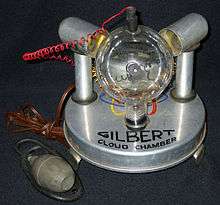Gilbert U-238 Atomic Energy Laboratory
The Gilbert U-238 Atomic Energy Lab is a toy lab set that was produced by Alfred Carlton Gilbert, who was an American athlete, magician, toy-maker, business man and inventor of the well-known Erector Set. The U-238 Atomic Energy Lab was released by the A.C. Gilbert Company in 1950. This lab's intention was to allow children to create and watch chemical reactions using radioactive material.
The lab contained a cloud chamber that allowed the viewer to watch alpha particles travel at 12,000 miles per second, a spinthariscope that showed the results of radioactive disintegration on a fluorescent screen and an electroscope that measured the radioactivity of different substances that were in the set. This toy is looked upon as being dangerous because of the radioactive material in the set, but Gilbert claims that none of the materials could conceivably prove dangerous.[1]
Unlike Gilbert's other chemistry sets that his company released, the U-238 Energy Lab never gained popularity and the toy was taken off shelves only a year later, selling only from 1950 and 1951.
Background
Gilbert believed that toys were the foundation in building a "solid American character" and many of his toys had some type of educational significance to them. Gilbert was even dubbed “the man who saved Christmas” during World War I when he convinced the U.S. Council of National Defense not to ban toy purchases during Christmas time.[2]
The Atomic Energy Lab was just one of a dozen chemical reactions labs that were on the market at the time. For Gilbert’s toys, he often included instructions on how the child could use the set to put on their own “magic show.” For parents, he pushed the idea that the sets that used chemical reactions set up their child in the right direction for a potential career in a science or engineering related field.[3]
Description


The set originally sold for $49.50 ($488 today)[4] and contained the following:[5][6]
- Geiger-Müller counter
- Electroscope
- Spinthariscope
- Wilson cloud chamber
- Low-level radiation sources:
- Four uranium-bearing ore samples
- Alpha particles (Pb-210 and Po-210)[7]
- Beta particles (Ru-106)[7]
- Gamma rays (possibly Zn-65)[7]
- Nuclear spheres for making a molecular model of an alpha particle.
- Prospecting for Uranium — a book
- Gilbert Atomic Energy Manual
- "Learn How Dagwood Split the Atom" comic book
- Three C batteries
- 1951 Gilbert Toys catalog
A product catalogue describes it as follows: "Produces awe-inspiring sights! Enables you to actually SEE the paths of electrons and alpha particles traveling at speeds of more than 10,000 miles per SECOND! Electrons racing at fantastic velocities produce delicate, intricate paths of electrical condensation--beautiful to watch. Viewing Cloud Chamber action is closest man has come to watching the Atom! Assembly kit (Chamber can be put together in a few minutes) includes Dri-Electric Power Pack, Deionizer, Compression Bulb, Glass Viewing Chamber, Tubings, power leads, Stand and Legs."
Development and legacy
In 1954, Gilbert wrote in his autobiography, The Man Who Lives in Paradise, that the Atomic Energy Laboratory was “the most spectacular of [their] new educational toys.” Gilbert wrote that the government unofficially encouraged the set's development because they believed that the lab would aid in public understanding of atomic energy and stress the constructive side of atomic energy. Gilbert also defended the Atomic Energy Laboratory, saying that it was completely safe and accurate, and some of the country’s best nuclear physicists had worked on the project.
Gilbert believes that Energy Atomic Laboratory was unsuccessful because the lab was for those who had some educational background rather than the younger crowd that the A.C. Gilbert Company usually aimed for. Columbia University purchased five of these sets for their physics lab.[8]
References
- ↑ Gilbert, A.C. (1954) The Man Who Lives in Paradise' (pp. 333-334).
- ↑ Watson, B (1999) Hello Boys! Become an erector master engineer. Smithsonian, 30(2), 120
- ↑ DiVernieri, R. (2008, September) "Stinks and bangs: They heyday of the chemistry set." Endeavour 32(3) 107-110
- ↑ Inflation.
- ↑ American Memorabilia
- ↑ Google Answers,
- 1 2 3 Oak Ridge Associated Universities, retrieved December 26, 2009
- ↑ Gilbert, A.C. (1954) The Man Who Lives in Paradise (pp. 333-334).
External links
- A. C. Gilbert U-238 Atomic Energy Lab by Frank J. Leskovitz
- Oak Ridge Associated University Atomic Toys' page
- Listing on an Erector / Gilbert fan site
- Very bad toys: Atomic Energy Lab usa ca. 1960